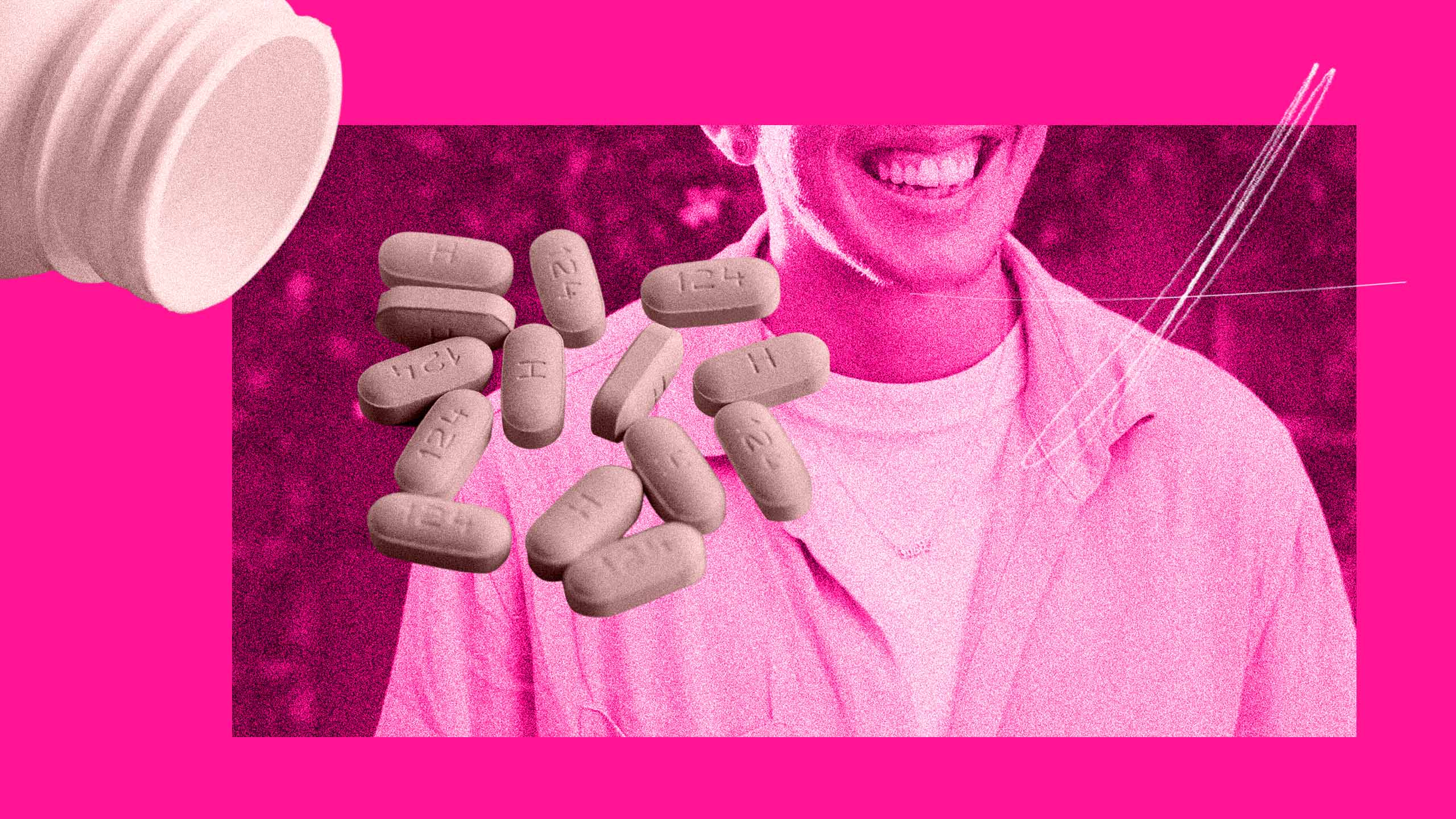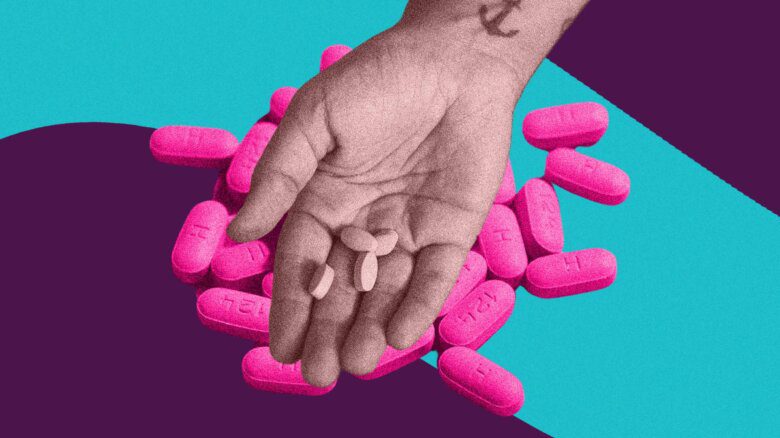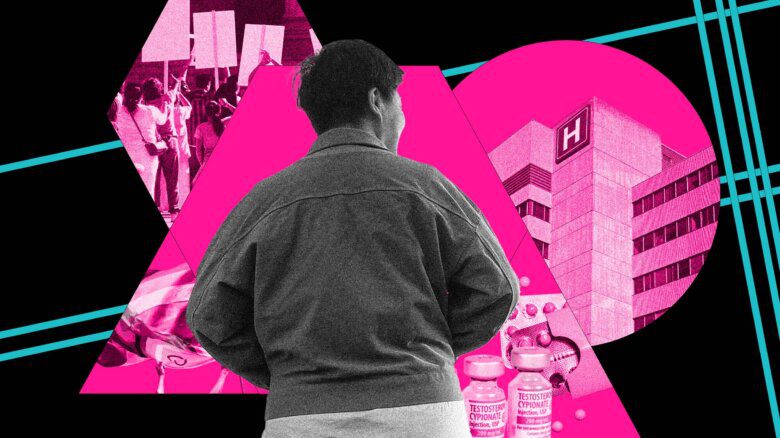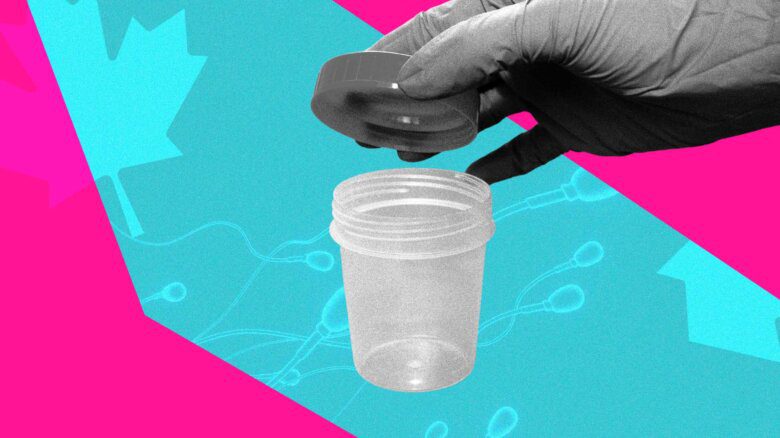I learned about the HIV-prevention drug PrEP not through a public health campaign, but through watching the second season of How to Get Away with Murder. It was 2015, and I was watching the legal thriller after seeing gifs on Tumblr of Connor (Jack Falahee) kissing men. The first season had ended with Connor’s boyfriend Oliver (Conrad Ricamora) being diagnosed with HIV, and season two saw Connor start PrEP. At the time, I didn’t understand why I was so drawn to their story or how it offered the representation I desperately needed. I was a long way from realizing that I, too, am a queer man, and even further from realizing that PrEP might be for me.
PrEP had been approved by the FDA three years prior, but it wouldn’t be available in Scotland, where I live, until 2017. Back then, I had told exactly one person that I was queer, and the show was the first time I had seen queer sex on screen. A full four years before I had sex myself, I got to watch queer desire and conversations about safer-sex practices. It’s funny—by which I mean horrific—that a TV show offered me more sex education than my entire high school experience had. Plus, mainstream media’s focus is storytelling, not comprehensive sex-ed lessons, so although I learned about PrEP, I was missing vital details. Nothing in Connor and Oliver’s story—or any other piece of information I heard about PrEP over the next few years, for that matter—suggested that the drug could be useful for trans men.
About 18 months ago, during an STI test, I mentioned to a nurse that I was trans and explained that I was exploring anal sex with my partner and would likely do so with other partners in the future. I was told that I should consider starting PrEP and given the number to call to make an appointment with the PrEP team at my sexual health clinic.
I left feeling incredibly gender-affirmed—being told I might need to be on PrEP validated my queer masculinity. But I was also confused. I’d mentioned that I was considering having anal sex with my girlfriend the last time I’d come into the clinic for an STI test, but hadn’t had the spoons to come out as trans during that previous appointment. Why had my supposed risk level gone up just because I finally told them that I’d changed my pronouns? Shouldn’t whether or not I was on PrEP be based on the kind of sex I was having?
It should. HIV treatment and prevention have come so far in the last thirty years, but policies and systems and language lag behind. Sexual health services need to recognize that they’re pushing away people who need access to them—transmasculine people deserve information about PrEP that includes us, but right now most of us aren’t getting that.
I wasn’t alone in my lack of understanding of who PrEP was “for.” Harry Nicholas, 27, is the author of A Trans Man Walks into a Gay Bar. He says that his sex-ed at school didn’t include any information about HIV because it wasn’t seen as something that women were at a high risk of contracting. It was ingrained in him that HIV was a cis gay issue and not one that could affect him, which he says, “was stupid because I now understand myself as a gay man, and HIV can affect anyone, but I just didn’t think it would affect me.”
Harry wasn’t aware of PrEP until it was mentioned to him at the specialist trans sexual health clinic he went to in London. This was in 2019, and Harry became one of 150 trans men to take part in the PrEP Impact Trial in the U.K., who made up 0.62 percent of the trial’s 24,255 participants.
Four years later, PrEP is now available on the NHS throughout the U.K., but the public’s perception of who PrEP is for hasn’t changed. Many people still see HIV as something that only affects gay and bi cis men—something that has never been true. A 2021 study estimated that transmasculine people were 6.8 times more likely to be living with HIV compared with general population rates worldwide. These numbers are consistent with research by Dr. Asa E. Radix, who works at the Callen-Lorde Community Health Center in New York, which found a “heightened burden of HIV among transmasc individuals attending our clinic who have sex exclusively with cisgender men.” The study found an HIV prevalence of over 11 percent (significantly, the general HIV prevalence in the U.S., which is currently less than 0.5 percent). While scientists have some theories as to why there is a difference in prevalence, more research is required.
Transmasc people are at risk of HIV, yet PrEP uptake among them is low. Dr. Radix says that trans men are “less likely to be screened for HIV and also less likely to start PrEP” than gay and bi cis men and trans women. Canadian guidelines recommend PrEP for trans people who have anal or frontal sex without a condom with partners whose HIV status is unknown or with partners who are HIV-positive and whose viral load is detectable. They also recommend it to trans folks who share injection-drug-use equipment. Despite this, the 2018 Sex Now survey, which charts the health of sexual and gender minority men across Canada, found that HIV-negative trans and non-binary respondents were two to three times less likely to report PrEP use than cis respondents.
Additionally, research in the U.S. found that only a third of transmasc participants who were eligible for PrEP had received any information about it from their doctor, and only 11 percent of those who were eligible had received a PrEP prescription. The study defined participants who were eligible for PrEP as those who reported having condomless receptive frontal or anal sex sex in the past six months, having an STI or more than five sexual partners in the last year, or engaging in sex work in the past six months.
The U.K. charity Aidsmap says that while HIV research has historically excluded trans men, the research that has been done shows that trans men have “reduced access to sexual healthcare” compared to gay and bi cis men. A number of factors impact this, including the negative and often transphobic experiences transmasc people encounter when accessing healthcare—which can range from being misgendered at appointments to being refused care because of their transness. Clinics that offer trans-inclusive sexual health services are rare, and access to PrEP for trans people requires medical professionals to have sufficient knowledge of both PrEP and trans healthcare.
Radix says that the discrimination trans people face in trying to access healthcare “results in delays or non-engagement in healthcare, including HIV prevention like PrEP or HIV screening.” The myth that trans men are at low risk for HIV also means that they haven’t been prioritized in PrEP research or outreach, Radix explains, and in turn that can contribute to a perception among transmasc folks about their apparent low risk of HIV.
Research published in the AIDS Patient Care and STDs journal says that internalized stigma also plays a role in how trans men approach safer-sex practices. If you are struggling with the fear that you could be rejected by gay or bi cis men partners because you are trans, there is a higher chance that you will consent to otherwise unacceptable sexual risks.
Another key factor in the low uptake of PrEP among transmasc folks is the myth that the drug will interact with gender-affirming hormones. However, PrEP is both safe and effective for transmasc people, and there are no known interactions between PrEP and gender-affirming hormones. Dr. Anand Patel, a doctor specializing in men’s health and sexual function in the U.K., explains that PrEP is safe to use with all hormonal contraception, if you are pregnant, if you are breast- or chest-feeding, and—perhaps most important for many transmasc folks—if you are taking testosterone.
“When my appointment finally rolled around, I was nervous, and the language used during the consult did nothing to put me at ease.”
After the STI-testing appointment where the nurse suggested I might start PrEP, I made an appointment to assess my eligibility. There was a two-month-long waiting list. Compared to my wait for a gender clinic appointment, two months didn’t feel very long, but waiting lists for PrEP have a real impact. Not PrEPared, a report from a number of HIV and sexual health organizations in the U.K. published in November 2022, found that most waiting lists were over twelve weeks, and only 35 percent of respondents reported that they had successfully been able to access PrEP from sexual health services.
When my appointment finally rolled around, I was nervous, and the language the healthcare professional used during the consult did nothing to put me at ease. The term “MSM” (men who have sex with men) was used and, although I’m a man, the only two people I’ve been having sex with in the past year aren’t. They’re non-binary and transfemme, so while the type of sex we’re having does still make me eligible for PrEP, especially considering how all three of us are non-monogamous, the term MSM misgenders them.
Aside from navigating language that didn’t fully reflect the sex I have, I was worried that my use of condoms during anal sex would mean I wasn’t eligible to start PrEP. As an anxious person, I personally felt I would be more comfortable using both safer-sex tools: condoms can break, after all, and while PrEP prevents HIV transmission, it won’t stop you from getting other STIs.
Thankfully for me, at the end of my appointment, the nurse assessing me confirmed that I could start PrEP—and that I could pick up my first three-month supply from the sexual health clinic the following day.
While I got the care I needed, condom use is a barrier to accessing PrEP that other transmasc folks have encountered. Z (who asked to be referred to only by his first initial to protect his privacy) is based in New York and says that their healthcare provider initially saw them as too low risk to offer them PrEP due to a low number of sexual partners and a high condom adherence. Z says, “After being denied PrEP, I had a sexual encounter with someone HIV-positive in which the condom broke. While the risk was low, I was very in my head about it.” Z sought out PEP—a combination of HIV drugs that can stop an HIV infection after the virus has entered a person’s body—and then renewed the Truvada in the prescription so they could remain on PrEP.
Will, a 23-year-old American living in London (who requested to be referred to by his first name only), isn’t currently taking PrEP, and has had difficulties accessing it in the past. He says that it feels like people are so focussed on making language inclusive that they forget to make policies inclusive. “I also found my doctor was trying so hard to use the right language that she didn’t know how to discuss risk factors and bodies. She asked my partner’s pronouns, but did not ask what type of sex we have and what the genitalia of my partner’s is, which is the most relevant aspect.” He believes that medical professionals need to focus not only on including trans people by validating our gender—which is undoubtedly important—but also through awareness of experiences and risks unique to trans people.
This lack of inclusivity is also reflected in PrEP research. According to cliniQ (a trans-led non-profit organization in London offering sexual health services to trans people in partnership with King’s College Hospital) as of November 2015, “no existing clinical trials for PrEP [had] trans men in their samples.” Today that has changed, but research into PrEP’s effects on trans patients is still limited.
In clinical trials, for example, PrEP has been used in two different ways: daily dosing, where you take a tablet every day, and event-based dosing, where you only take PrEP when you are going to have sex. The Terrence Higgins Trust (the U.K.’s leading HIV and sexual health charity) recommends daily dosing for transmasc people taking testosterone because there is “insufficient data” about other dosing options and testosterone can cause vaginal atrophy—decreasing natural lubrication, increasing the chance of damage to frontal tissue, and potentially creating additional routes for HIV transmission.
As the Human Rights Campaign points out: “In the vast majority of studies [of HIV], transgender people have only been counted as their sex assigned at birth, which not only discounts their identities but leaves them relatively invisible.” That invisibility is just another example of how healthcare systems are hostile to trans people.
Eli, 23, (who requested to use his first name only due to sharing his and his partner’s status) has a partner who is HIV-positive. He initially struggled to access PrEP due to the invisibility of his specific needs. When he would approach organizations to discuss starting PrEP, they would explain to him that U=U—meaning that if someone has an undetectable viral load, they cannot sexually transmit HIV to others. While Eli acknowledges this is important information, it’s also information that he was aware of. What he needed was to have “honest and open conversation with a doctor about what to do if my partner wasn’t taking their meds, which is a situation that presented itself multiple times within my relationship as my partner was sometimes required to come off their HIV meds to pursue different treatment courses for other issues.”
Eli feels like he was dismissed due to his monogamous status, but also because of his transness, as organizations didn’t see him as “high-risk enough” and “reduced” him to the statistics for vaginal transmission of HIV—which wasn’t exactly gender-affirming for a transmasculine person. It wasn’t until he accessed TransPlus (the first integrated Gender, Sexual Health and HIV service commissioned by NHS England) that he was able to talk to a doctor about the needs of his relationship, and how PrEP could allow him to share the responsibility of safer sex in his relationship, rather than leaving it all to his partner.
While HIV prevention campaigns and treatments are rarely geared toward us, trans people have been living with and dying of AIDS alongside our queer siblings since the ’80s. But the systems of healthcare that queer and trans communities fought for and won were overwhelmingly set up by straight cis people—and straight cis people largely continue to maintain those systems to this day.
Still, there are people working to make changes within those healthcare systems. Dr. Radix’s research, for example, is focused on “[reminding] clinicians how important it is to include transgender men and non-binary people in HIV prevention programs.”
Dr. Will Nutland, a public health doctor and co-founder of PrEPster, says that outreach services are incredibly important in reaching people who might not realize that they benefit from PrEP—especially outreach workers who are from those communities themselves. In this case, that would be transmasc people talking to other transmasc folks about PrEP. Similarly, Eli would like to see explicitly trans campaigns for PrEP—and sexual health in general. He says that the “current approach of sometimes including a passing trans person within a campaign isn’t explicit enough as it relies on the viewer to have an existing knowledge of the person’s gender identity to feel included.”
And in the last few years, the lack of data is finally being addressed. After specific research into the impact of gender-affirming hormones on both trans men and trans women, the San Francisco AIDS Foundation’s clinic (where the study was conducted) now offers event-based dosing to trans people whose only exposure to HIV would be through anal and not frontal penetration.
“Taking PrEP connects me to the generations of queer and trans people who fought for queer rights.”
I’m thankful that, despite the barriers, I was ultimately able to advocate for myself and access the care I need. As much as I know that PrEP isn’t just for men and I’m frustrated by the lack of messaging around that, picking up my first PrEP prescription from my local sexual health clinic felt gender-euphoric. I’ve taken the drug every day since. I feel like it connects me to the generations of queer and trans people who fought for queer rights and ensured that I got to figure out my sexuality and gender in a world that isn’t free from transphobia or bigotry, but where gay marriage has been legal and PrEP available on the NHS my entire adulthood.
Taking PrEP makes me feel confident, sexy and proactive about my sexual health. It connects me to and allows me to celebrate my own queer masculinity.

 Why you can trust Xtra
Why you can trust Xtra


